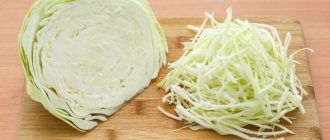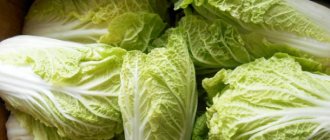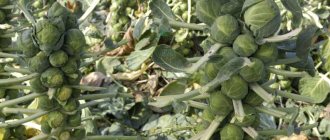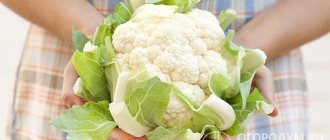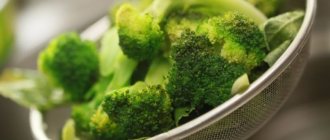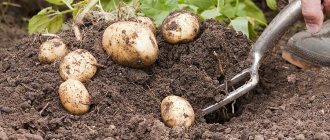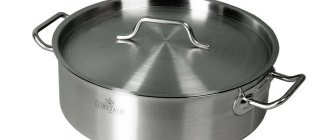Choosing the right cabbage for pickling
For this purpose - pickling - only late-ripened varieties of cabbage are suitable. Therefore, the preparation is often done before winter and for a long time, fermenting a large volume of leafy vegetables so that it lasts until spring. Also, late-ripening varieties are chosen because of their increased density, which also increases the taste characteristics of the pickles.
Cabbage, which reaches technical maturity in the summer season, is a good addition to vitamin-rich vegetable salads. But when fermented, it cannot sit for long. Under the influence of table salt, the fibers of cabbage leaves of early and medium varieties soften, lose some of their vitamins, taste and do not crisp. At the same time, not all cabbage heads are suitable for pickling, but only those forks that meet the following characteristics:
- when squeezed, the cabbage head does not deform and retains its elasticity;
- there is no damage on the surface of the cabbage leaves;
- the stalk is light green or cream, without rings or other dark markings;
- The cabbage head does not have limp, rotten or frostbitten leaves.
On a note! For long-term storage of sauerkraut, you must follow all recommendations.
If the forks have been damaged, the pickled vegetable will have a shorter shelf life. Also, you need to take into account that early or middle varieties can be fermented, but such cabbage will only be tasty for a few days, then it begins to sour.
Instant marinated cabbage with bell pepper
This recipe makes incredibly tasty and crispy pickled cabbage with instant bell peppers. Some housewives are accustomed to pickling cabbage with onions, but with garlic it turns out no worse. You can eat it after 6-8 hours, which is good news. You just need to chop the cabbage with vegetables, pour in the hot marinade and leave under pressure for several hours. And that’s it, the cabbage is ready. Such cabbage will definitely not last long in your refrigerator, so for a large family it is better to prepare a double or even triple portion at once. We invite you to get acquainted with the step-by-step photo recipe.
From this amount of ingredients you get 1.5 liters of ready-made pickled cabbage.
Ingredients:
- cabbage (without stalk) – 1 kg;
- carrots – 1 piece;
- bell pepper – 1 piece;
- garlic – 3 cloves;
- purified water – 350 ml;
- table salt – 1 tbsp;
- granulated sugar – 70 g;
- sunflower oil – 70 ml;
- vinegar 9% - 70 ml;
- cloves – 1 piece;
- black peppercorns – 2 pcs;
- allspice peas – 2 pcs;
- bay leaf – 1 pc.
How to make instant pickled cabbage
Cabbage should be taken late, flattened with almost white leaves. Chop the cabbage and place in a suitable sized bowl. There is no need to crush it.
Grate the carrots on a coarse grater or cut into strips, as desired.
Cut the sweet red bell pepper into half rings or quarter rings, depending on its size. You can also cut it into cubes. Even frozen peppers will work. This is exactly the one I took. You can't tell by the taste of the finished salad whether it was fresh or frozen.
Cut the garlic into small cubes.
Mix all the vegetables, remembering that there is absolutely no need to mash the cabbage.
Transfer the shredded cabbage with vegetables to a saucepan in which it will marinate.
For the marinade, pour purified water, sunflower oil into a saucepan or ladle, add table salt and granulated sugar. Boil and do not remove from heat for another 3 minutes. Then pour in the vinegar and add all the spices: cloves, black and allspice, and bay leaf. Turn off the heat and cover with a lid to prevent the vinegar from dissipating.
Pour the hot marinade into the pan with the cabbage.
Place a plate of suitable size on top and place a jar filled with water on it. Leave it like this for 6-8 hours.
After time has passed, remove the pressure and transfer all the cabbage into jars. Place the pickled cabbage in the refrigerator and store it there.
Instant pickled cabbage with bell pepper is ready. Cook it yourself and share this wonderful recipe with your loved ones.
Storage utensils
How long sauerkraut can be stored in the refrigerator or in another place depends on the container in which it is kept. Previously, only oak barrels or other smaller containers were used for this, but now there are more types of containers suitable for storing dishes. Moreover, if you choose wooden containers for storing the product, you must take into account that the material can impart its aroma to the product. Therefore, if the dishes are old, the sauerkraut will have an unpleasant aftertaste.
The best container for storing the product is one made of glass or ceramic. Such dishes actually do not absorb third-party odors compared to wood. In this case, a container for storing sauerkraut made of steel or aluminum is not a suitable choice. The product will receive some metallic aftertaste, which will significantly degrade its original flavor characteristics. If there is no other utensil other than metal, then you need to choose enameled one, the coating of which does not have any damage - chips, cracks.
Conditions
Long-term storage of sauerkraut is possible only if all conditions are met.
Mandatory requirements are a temperature range from 0°C to +4°C . At a higher temperature, the fermentation process of the product does not stop, it peroxidizes and disappears.
The absence of light is another prerequisite. When exposed to light, microelements and vitamins are destroyed. To prevent this, the room must be dark.
The humidity level is also important , since even at 60% the upper part of the workpiece will begin to dry and the brine will evaporate.
If you continue to keep already fermented cabbage warm, it will lose its taste and become unfit for consumption.
Storing sauerkraut
Fermenting cabbage is quite simple, but preserving its freshness is more difficult - for this you need to follow all the rules and provide certain conditions for harvesting. It’s better when the product is prepared a little at a time, but when there is nowhere to keep fresh cabbage forks - for example, in an apartment, a large volume of vegetables is fermented at once. But keeping it fresh and suitable is quite difficult, since there is not much space in the refrigerator, and the basement is not always accessible. Storage conditions and freshness of sauerkraut are interrelated.
Temperature and humidity
It is recommended to keep sauerkraut at a temperature that is close to 0˚ C, but does not exceed +3...+4˚ C and not minus. However, you can leave the product at +10˚ C for a short time, but in this situation, fermentation will go further and the risk of peroxidation of the shredded leaf increases. If the thermometer mark is below 0˚ C, the product will begin to freeze, and after thawing it will lose its original structure - it will become soft and stop crunching. Because of this, sauerkraut is not kept on the open balcony in winter, but is sent to the refrigerator, underground, or glazed loggia.
Protecting pickles from mold
On the surface of the brine, when sauerkraut is kept in a pickling container, a whitish coating appears that looks like mold. This phenomenon is the result of the activity of yeast fungi and is actually classified as mold, which negatively affects the product. When such a film appears, the pickle loses its taste and original consistency, and the product becomes loose. You can solve the mold problem by adding mustard or horseradish to sauerkraut. This processing of the workpiece prevents the development of yeast fungus and gives some piquancy to the product.
Attention! You must not overdo it with the amount of horseradish or mustard powder, as these components have a specific taste and in large quantities they can spoil the sauerkraut, making it overly spicy.
It is permissible to use not only mustard powder, but also whole mustard seeds. They are folded into a gauze bag and placed in a container in which sauerkraut is kept. It is better if the mustard seeds are approximately in the middle of the pickle. To prevent the development of yeast fungus, horseradish is crushed - using shavings. But, this ingredient is added to sauerkraut only after it is ready. If you add horseradish earlier, the vegetable may not ferment, but will only be salted - if there is enough salt.
Brine quantity
Sometimes sauerkraut is stored without brine - it is drained. But you can’t do this, since the brine retains vit. C present in pickles, preventing its rapid destruction. Therefore, do not drain the liquid and make sure that it covers the shredded sheet completely. For this purpose, oppression is used. The absence of brine actually has no effect on the taste characteristics, but the usefulness of the product decreases. Therefore, the salted liquid is drained only immediately before serving the sauerkraut.
Using Preservatives to Keep Pickles Fresh
The main value of the product lies not only in the high content of vit. C, but also in an increased volume of coarse fibers, which have a positive effect on digestive function. However, the shelf life of the product is limited and to increase its shelf life, it is acceptable to use some preservatives. To do this, use the following:
- Sugar helps preserve the taste characteristics and density of the pickle. This preservative is poured in a thin layer on the surface of the sauerkraut in the container in which it is kept.
- Table vinegar is also suitable for increasing the shelf life of pickles. This preservative is added in a small amount to the container in which the workpiece is kept. But, you need to take into account that acetic acid slightly changes the taste characteristics of the pickle.
- You can add more table salt when preparing sauerkraut, but the taste characteristics of the pickle will be different and not entirely traditional. This pickle is more suitable for use as one of the ingredients in hot dishes.
- Vegetable oil is also suitable for prolonging the freshness of sauerkraut. It is poured into a container so that an oily film appears over the entire surface of the brine. It will stop air contact with the workpiece, which will inhibit the reproduction and development of pathogens that cause rotting.
On a note! When the pickle is over-acidified, even despite the preservatives used, it can be used to prepare cabbage soup or another similar dish.
Before adding, sauerkraut is washed with cold running water. Also, 1 tsp helps to improve the situation somewhat. sugar (approximately 0.5-1 kg of product), added to the pickle before serving.
How long is the product suitable for consumption?
Temperature is not the only condition that allows you to preserve the original taste and beneficial characteristics of the product for a long time. To increase storage time, the following conditions are required:
- The container in which the cabbage is kept must be opaque and protect the contents from exposure to sunlight.
- Humidity levels in the room where the workpiece is located should be slightly above average, at the level of 85-95%.
The shelf life of a product without noticeable changes in taste and appearance differs depending on where and under what conditions it is stored:
- Refrigerated cabinet - the time during which the cabbage does not spoil depends on how sealed the container is in which it is kept and the temperature (completely sealed and +4 ̊C - shelf life 3 months, container without a lid - 10 days).
- Cellar – the preparation is edible for 3 months, the rest depends on the recipe used.
- A room with a temperature in the range of +6...+10 ̊С – 2-4 weeks.
- In a living room at a temperature of +10 °C, you need to eat the product within 2-3 days.
- On a glazed loggia or balcony at a temperature of 0...+5 ̊С – 4-5 months.
- In the freezer - can last up to 8 months, but subsequent freezing is unacceptable. After thawing, the product must be consumed within 5 days.
Attention! Not only compliance with the humidity and temperature conditions in the room allows you to prolong the freshness, preserve the original appearance, taste characteristics and suitability for consumption of the marinated dish. You can increase its shelf life with the help of a properly selected recipe according to which you plan to marinate.
Storage location for fermented product
It is believed that a cellar or basement is a suitable place for storing sauerkraut and other pickles. This is due to the fact that in the basement the temperature regime is optimal for maintaining the freshness of such products. Also, sunlight does not enter the underground, contact with which is contraindicated for pickles, since under the influence of ultraviolet radiation they begin to rapidly deteriorate. In addition to the above, in a good cellar or basement, air humidity levels are optimal for keeping pickles fresh.
However, there are also negative aspects of storing sauerkraut in the basement. So, if pickles are kept underground, the likelihood of mold developing is higher. And you cannot send sauerkraut to the basement or cellar in the case of an apartment. In this situation, a glazed balcony, loggia or refrigerator is a good place to store pickles. It is also acceptable to keep sauerkraut in a cool pantry. At the same time, in a warm room, where the temperature is above +18˚ C, the product is added in portions - one time at a time. The remaining cabbage, if the entire volume brought was not eaten immediately, is not put back into the brine - it is stored separately from the main volume of the workpiece, in the refrigerator.
Cellar storage
You can store pickles underground for a long time, especially when the sauerkraut is placed in glass jars that are sealed with metal lids. However, you cannot completely fill the jar with the product - there should be no contact of the pickle or brine with the metal. In the autumn-winter season, as well as at the beginning of spring, sealed jars will well maintain the freshness of the product. But, with the onset of summer, the maximum shelf life of sauerkraut is approximately 1 month, since the temperature in even a well-buried underground does not drop below +7˚ C.
In addition to sealed jars, pickling can be stored in enamel buckets or pans, the lids of which fit tightly. If there is no lid, then they make a squeeze - a plate or lid is placed on top of the product, which will press the pickle due to a jar of water placed on top. It is also acceptable to keep sauerkraut in ceramic barrels, but it is important to check that the container is clean. In the case of wooden utensils, no foreign odors should come from them, as the pickling will absorb them, which will spoil the taste of this product.
On a note! When storing sauerkraut in an enamel bowl, it is important that there is no damage to the enamel, since the pickle will oxidize in case of direct contact with metal and its shelf life will expire faster.
In the apartment on the balcony
In apartment conditions, you can also choose a place to store sauerkraut, in which its shelf life will be as long as possible. Since there is no underground space, pickles are often sent to the refrigerator. However, when a lot of sauerkraut is prepared, it is impossible to place its entire volume in the refrigerator. In this situation, the pickles are left on the balcony - if it is glazed and insulated enough so that there is no minus on it.
It is also permissible to send sauerkraut to an unglazed balcony, but in this case it is recommended to pack it in portions. This is due to the fact that in the case of sub-zero temperatures, the pickles will be frozen, and they cannot be exposed to this effect again. Also, one must take into account that already frozen sauerkraut is worse and its maximum storage duration at a temperature of +1...+4˚ C does not exceed 1-4 days.
However, it is not recommended to leave pickles even on an unglazed balcony in the climate of the southern regions. This is due to the relatively mild winter, since the temperature on the street and, accordingly, on the balcony, can increase to +7...+10˚ C. This thermometer mark does not contribute to increasing the shelf life of pickles. At the same time, there is also no stability of temperature in winter - the thermometer mark changes from positive to negative values. Repeated freezing negatively affects the condition, consistency, taste characteristics and shelf life of sauerkraut.
Storage in plastic containers
When storing products prepared using the fermentation method, you can use polymer containers. But it is also necessary to take into account the characteristics of the composition and the shortened period. If there is no marking on the container, then there is a high probability of using melamine - such dishes are toxic. Plastic marked PP (PP - polypropylene) poses a low risk - dishes for feeding children and food containers are often made from this material. Also, the following notes are suitable for storing pickled shredded cabbage leaves:
- HDPE (HDPE - low-density polyethylene);
- PET, PETE (PET – polyethylene refthalate);
- OTHER (Other - the mark in the form of a spoon and fork is important).
PVC containers (V, PVC - polyvinyl chloride) cannot be used for acidic workpieces - it is a toxic material that is applicable only for technical purposes. When freezing, it is strictly not recommended to use containers with MDV markings (LDPE - low-density high-density polyethylene). You can put the sauerkraut in boxes marked as PS (PS - polystyrene), but we must not forget about the negative fumes when heating such containers.
On a note! When choosing high-quality plastic for food use, you can preserve pickles longer than in enamel containers. But, such containers must be tightly closed and kept in a cool place.
Storage in banks
Glass is one of the most inert materials, so long-term storage of an acidic product in such containers is possible. Containers made of this material must be checked for integrity before use, especially in the neck area. Glass jars, before placing shredded sheets in them, must be washed with a soda solution and sterilized with steam or heated in a convection oven.
Such containers must be closed with a thick polymer lid intended for preservation - they fit more tightly and must be heated before closing. You need to be careful when handling glass containers with the product - jars can easily be broken by accident. Also, when storing on the balcony for a long time, you need to take into account the temperature regime - if it’s frosty outside, it’s better to put the container with sauerkraut in a warm place.
Warm sauerkraut
Storing an acidic product in a warm room is doubtful, but possible. A tightly covered vessel with cabbage can be left in the kitchen or in a warm room, and it will not be immediately spoiled. But, to extend the shelf life and preserve the taste and beneficial components, it is necessary to update the brine with one of the main preservatives - sugar. It needs to be poured on top every 2-3 days.
This additive is converted into acid in the acidic environment of fermentation under the influence of bacteria. But, when stored in a warm place, be sure to monitor the general condition of the product and take into account the risks of mold development. When a dish is over-acidified, sugar can also correct the taste. On a large plate, just add 1-2 tsp. granulated sugar and mix thoroughly. It will not be possible to restore density this way, but the taste of the product will be normal.
Attention! It will not be possible to save pickles that already have mold in them - the fungi quickly spread their spores into the through space and such cabbage will simply have to be thrown away.
Freezing cabbage
The preparation of such pickles includes fermentation processes, therefore, when using freezing as a method of preserving this useful product, we must not forget about the characteristics of microorganisms. When the ambient temperature drops to below 0ºC, the bacteria causing the fermentation process not only slow down their activity - they die and are not restored after defrosting.
To preserve all the beneficial qualities of the leafy vegetable, it is recommended to first drain the brine into a separate bottle and simply store it in the refrigerator. After defrosting a portion of pickles, it is rinsed in liquid and served. You need to freeze it in small portions so that the product can be eaten at one time. Cannot be re-frozen.
What container is best to store it in?
The choice of containers for long-term storage is made taking into account the space designed to contain stocks in the winter. Glass jars are the most common option, especially for city apartment conditions.
Plastic containers
A small amount of cabbage, which is intended for consumption in the near future, can be packaged in plastic containers with lids. The presence of a lid is mandatory, as it prevents air from entering the product .
The duration of storage of cabbage in plastic is up to 6 days if it is open, and a month and a half if it is hermetically sealed.
Plastic containers must be designed specifically for storing food.
Glass jars
Glass jars are the best option, especially when space is limited, such as in the refrigerator.
First, such containers must be thoroughly washed with soda and sterilized . When laying out the workpiece, you need to make sure that there is enough brine in each of the jars.
Shelf life in glass is up to 1.5 months. If you pour a layer of sunflower oil on top of the container, the shelf life of the fermented cabbage increases.
Read more here.
Enameled pans
Enameled containers are also suitable for fermenting cabbage. It is convenient to mix the product and organize pressure in them to ensure good coverage with brine.
Before use, enamel containers must be inspected for chips , since damaged containers are not suitable for cooking due to health hazards.
Barrels
Oak barrels are a traditional container for fermenting cabbage. Wooden barrels improve the taste of the product and allow you to get by with just a few containers for large-volume preparations. Since such a container is not only capacious, but also voluminous, cabbage can only be stored in it in cellars, at a temperature of about +2°C.
When taking out the next portion of cabbage, you need to wipe the inner walls of the barrel with a cotton cloth soaked in a saline solution. This will prevent mold from developing.
If a film forms on the top layer due to contact with air, this must also be removed.
A wooden pressure wheel also needs to be treated in a salt solution . It is better not only to wipe it, but also to regularly soak it in a concentrated saline solution for 10 minutes.
In order for the barrel to serve for a long time, it should be placed in the cellar on a special pallet so that its bottom does not directly contact the cellar floor.
Duration of storage under different conditions
The duration of preservation of the properties of a fermented product is tied to many factors. The main ones are the cooking method, the material of the cookware and the ambient temperature. Additionally, the safety of the shredded leaf is affected by the use of additional preservatives - sugar, salt, vinegar and others. If you calculate the terms according to the storage conditions of a product prepared according to a classic recipe, you can derive the following indicators:
- Wooden tubs. The shelf life of the finished product can be up to 9 months, while maintaining a stable temperature from 0ºC to +3ºC.
- Glass vessel. At low temperatures, pickles in a jar retain their properties for no more than 3 weeks, and if the indicators are raised to +10ºC, then up to 3-5 days.
- Polymer containers. A shredded sheet can stand in plastic at a temperature no higher than 4ºC for up to 7 days, but much depends on the characteristics of the material.
Based on average indicators, it can be concluded that leaf vegetables prepared by fermentation should be eaten immediately. If you leave such a product for storage, then the optimal temperature is from +2ºC to +5ºC, and the container should be tightly closed. Stable maintenance of such an environment is only possible in the refrigerator, where sauerkraut can be left for a period of no more than 3 months.
Attention! It is difficult to preserve the benefits of a product in a container that is not tightly closed. Therefore, it is recommended to leave the forks whole for long-term storage and cook them as they are consumed.
Preparing for storage until spring
Most often, cabbage is fermented in fairly large volumes.
In order to protect it from damage and preserve maximum nutrients, you need to pay attention to a number of points.
Among them:
- choice of variety and heads of cabbage;
- correct salting technology;
- prevention of mold and drying of the top layer;
- selection of storage location and containers;
- maintaining the necessary storage conditions.
Preventing Mold Formation
A white coating on the surface of some workpieces is associated with the appearance of fungus. Even when removing it, you cannot be completely sure of the safety of the product.
The following techniques will help you avoid mold:
- Sprinkle grated horseradish on top of the packaged cabbage.
- Add sugar or mustard powder.
- When fermenting, add lingonberries or cranberries.
- If you use mustard seeds, it is better to first place them in small canvas bags.
Amount of brine: more or less?
When storing cabbage, you should make sure that the entire preparation is covered with a layer of liquid.
Without brine, the top layer will turn dark and deteriorate. Organizing oppression can be a solution to a problem.
Preservatives for pickling: what to choose?
Natural preservatives can ensure long-term storage of the product. They are used as follows:
- pour a little vegetable oil on top of the container with the vegetable - enough to just cover the cabbage;
- add just a little acetic acid;
- when fermenting, you can use more salt;
- Sprinkle the top of the compacted dough with sugar.
Natural products that are safe for health can give a good canning effect.
Useful tips
When fresh cabbage is stored for a long time, it begins to lose its beneficial properties, in particular, the amount of vitamin C decreases. When fermented, partial fermentation and partial preservation occur. By increasing the amount of lactic acid, most of the vitamins in the product are preserved. But sauerkraut prepared even according to all the rules must be stored in compliance with the conditions. Main recommendations for extending shelf life:
- You can freeze sauerkraut, but be sure to eat it after removing it from the freezer. The product cannot be re-frozen.
- The brine must be fresh and poured so that it completely covers the shredded leaf. Due to the presence of air, vitamin C leaves the product.
- Sugar can not only be a salvation for slightly sour cabbage, but also as an additional preservative. When it is added, the amount of acids rises.
- Pouring oil over the top layer inside the jar can further protect the cabbage from exposure to the external environment.
- If the pickled cabbage leaf is placed in the freezer, then it is better to drain the brine into a separate container, and after defrosting, keep the leaves in the brine.
Storing sauerkraut at home in winter is not difficult. A container with a useful product can simply be placed on the balcony, placed in a ventilated cellar, or placed in the refrigerator. But, the peculiarities of preparing shredded cabbage leaves involve fermentation. For this reason, it is necessary to constantly monitor the condition of the product and prevent peroxidation and the development of mold in the vessel.
Practical freezing
Freezing vegetables is a labor-intensive technology for preserving food. In this way, you can prepare greens, some vegetables and fruits for the winter. But is it possible to freeze cabbage in the freezer? Yes, as semi-finished products for preparing first and second courses.
The easiest way to prepare sliced cabbage is:
- Take fresh, tight heads of cabbage, remove the outer leaves, and cut out the stalk.
- Rinse the head under running water and let it dry.
- Cut the vegetable into small strips.
- Place the prepared cuts in plastic containers or plastic bags.
- Place the workpiece in the freezer compartment of the refrigerator.
Cabbage can be stored in the freezer longer than in the vegetable compartment - from 6 months. up to 1 year. You can use it immediately; there is no need to wait until the product thaws.
Frozen cabbage is not suitable for salads, as it loses its appearance and crunch. But for preparing hot dishes - just right
You can also freeze cabbage individual leaves. Such preparations are suitable for preparing cabbage rolls. To do this, use summer varieties or loose, loose heads of late ripening.
- For whole cabbage, remove the top leaves and the stem.
- Rinse and dry the vegetable.
- Carefully separate the heads of cabbage into individual leaves.
- Place the workpiece into bags in portions.
- Place the cabbage leaves in the freezer.
Frozen cabbage must thaw before cooking. To do this, place it on the bottom shelf of the refrigerator. When it softens, the dish can be cooked.
A big plus in favor of freezing cabbage for cabbage rolls is that the vegetable does not need to be boiled first. The leaves are quite soft after defrosting.
A matter of taste
How long cabbage is stewed depends on various factors. First of all, individual taste preferences play a role here. As a rule, the type of product also influences its readiness, and many believe that a vegetable exhibits its true taste when it darkens to a “café au lait” shade. At this stage of heat treatment, the cabbage becomes optimally soft, and a slight spiciness appears in the taste.
However, some prefer it only in half-raw form or as one of the ingredients in a vitamin salad. It should be noted that fresh cabbage can only be eaten by people with strong stomachs; it is less digestible and can lead to heaviness in the stomach. Experts consider the stewed version to be the most tender and healthy in this case.
Having determined how long fresh cabbage is stewed and with the amount of additional bright ingredients for it, the result is a delicious, aromatic dish that everyone at home, without exception, will appreciate.
Process Features
It is wrong to think that cabbage can only be stored in the cellar, although this is where ideal conditions have been created for it. In fact, vegetables overwinter on the balcony, in the refrigerator, in garages. Sometimes they are even buried in the ground.
At home
At home, cabbage can be stored in the refrigerator, in the vegetable rack. However, it will not be possible to place more than 2-4 forks in the box.
You can freeze cauliflower and savoy cabbage. White cabbage is placed in the freezer only after pre-processing: stewed or pickled.
Fresh heads of cabbage do not tolerate sudden cooling; after thawing, their leaves become soft and lose their taste. If you leave cabbage in your apartment, it will begin to spoil within 7-9 days.
Another place to store fresh forks is on the balcony. It must be glazed. Otherwise, the vegetables will freeze. On the loggia they are stored in foam-insulated boxes, which are covered with blankets or old jackets on top.
An important condition for storing cabbage on the balcony is maintaining a stable temperature. If there are constant changes, the vegetables will quickly begin to deteriorate.
Read more here.
In the cellar or basement
You can store cabbage in the cellar or basement until it warms up. The room must be clean and ventilated once a month. Place the heads of cabbage in any available way: hang them by stumps or put them in boxes.
It is recommended to insulate the forks by wrapping them in any available material, such as cling film or baking paper. They should not touch each other. In general, the smaller the area of contact between the cabbage and the surface, the better.
In winter, you need to periodically check your vegetables. If signs of rot are found, spoiled specimens are removed so that they do not infect healthy vegetables. Read more about storing cabbage in the cellar here.
In the garage
If the garage does not have a cellar, you can simply store cabbage on shelves or racks.
An unheated room freezes, so the heads of cabbage should be placed as high as possible from the floor. They must be wrapped in film and covered with blankets.
If the garage is heated, then you can lay out the cabbage on racks 20-30 cm high from the floor. Another option is to hang vegetables by their roots. It is necessary to ensure that the air temperature in the room does not rise above +8 degrees. Otherwise, the heads of cabbage will not go into “sleep mode” and will quickly deteriorate.
Plastic film helps protect vegetables from moisture loss, since it is difficult to achieve 95% air humidity in a garage.
In a pit in winter
If you protect vegetables from moisture and pests, and provide good ventilation, they will be stored well in the ground.
This method of storage requires time and physical effort, but cabbage from the pit remains fresh until the summer. To repel rodents, cover the trench with spruce branches, or spread poison around it.
Features of laying vegetables in a hole:
- In a suitable place, dig a trench 60 cm deep and 40 cm wide.
- The bottom of the pit is sprinkled with sand, and several poles are placed on top.
- The forks are placed in a trench in 1-2 layers, with the stumps facing up.
- Every 3 m a tube is installed that will provide ventilation to the pit.
- Fill the hole with sand or dry straw. In this case, you need to make sure that the material does not get into the tube.
- The top of the trench is sprinkled with a layer of clay 10 cm thick, after which up to 20 cm of soil is added. The clay will prevent moisture from penetrating inside, and the soil will protect the forks from frost.
- Additionally, the trench is covered with roofing felt or slate, making sure that the ventilation holes remain open.
- When enough snow has fallen, it is thrown over the trench to improve its thermal insulation.
How to store cauliflower
You can also store cauliflower on the balcony, however, it will be much more difficult, since this variety is more susceptible to rotting and withering. If you place cauliflower heads covered with film in a box and maintain a sufficient level of humidity and a constant temperature level of at least 0 degrees, you can store it for two months. You can pick the leaves from the head of cabbage and hang them from the ceiling without them; the vegetable can be preserved for 30 days.
Cauliflower can be stored for a long time if it is frozen. To do this, its heads are thoroughly washed in running water and boiled for several minutes. When they have cooled, they are torn into inflorescences, placed in separate containers, and then frozen. If frozen, cauliflower will keep for 12 months.
